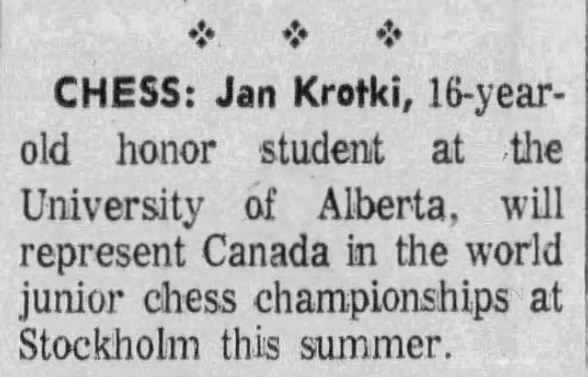 The Game of Kings 09 Jan 1969, Thu The Gazette (Montreal, Quebec, Canada) Newspapers.com
The Game of Kings 09 Jan 1969, Thu The Gazette (Montreal, Quebec, Canada) Newspapers.com
Thus Spake M. Botvinnik
Former world champion, Mikhail Botvinnik, who at 57 is still capable of trouncing most of the younger grandmasters, is a keen commentator of the current crop. Here is his up-dated view of Robert Fischer, published in “Chess” magazine:
“At 25 Fischer is now the sort of legendary figure that Tal once was. You have to agree that he is outstandingly talented. He analyzes superbly, plays most energetically, has a fine competitive temperament and great resourcefulness. He can both hold out in defence and attack hard. His nerves respond to any demands on them.
“A general appraisal of his games gives the impression of a typical Soviet grandmaster in his style of play. We should be pleased to have such a player on our team.
“But there is another Fischer. Apart from his outstanding chess talent there is the question of his general intellectual development. ([“General Intellectual Development?” Autism Spectrum Disorder (ASD) is categorized by professionals under the umbrella of “Intellectual Development Disability—IDD, not mental illness.]) This is probably on about the level of a 14 or 15-year-old child.
“His character is unstable. He is too easily provoked. You could say he is naive and does not really understand life. He makes hasty decisions which at times harm both himself and chess. It is all very sad. ([Only sad in that people in the chess world have yet to embrace scientific enlightenment; tolerant, acceptance of diversity, supportive for those with disability and better human beings capable of compassion.]) His absence from the Candidates' matches certainly reduced interest in them.” ([Exactly, and whose fault was that, Mr. Botvinnik? Since Fischer we understand today, was on the Autism Spectrum.])
From the Vinkovci, Yugoslavia International, 1968:
Emil Nikolic vs Robert James Fischer
Vinkovci (1968), Vinkovci YUG, rd 9, Sep-18
English Opening: Great Snake Variation (A10) 0-1
1. c4 g6
2. Nc3 Bg7
3. g3 e5
4. Bg2 d6
5. e3 Nf6
6. Nge2 O-O
7. O-O c6
8. d4 Re8
9. Rb1 e4
10. b4 Bf5
11. h3 h5
12. Nf4 Nbd7
13. a4 Nf8
14. c5 d5
15. b5 N8h7
16. Bd2 Ng5
17. Rb2 Qd7
18. Kh2 Bh6
19. a5 Bg4
20. hxg4(a) hxg4
21. Rh1 Nf3+
22. Bxf3 gxf3
23. Kg1(b) Bxf4
24. exf4 Kg7
25. f5 Rh8
26. Bh6+ Rxh6
27. Rxh6 Kxh6
28. Qd2+ g5
29. bxc6 Qxf5
30. Nd1 Qh3
31. Ne3 Kg6 0-1
(a) Must take, or Black goes 20. … B-B6.
(b) Now the K is in a box with no chance of escape as Black soon gets complete control of the K-R file.
 Chess: Jan Krotki 13 Jan 1969, Mon The Gazette (Montreal, Quebec, Canada) Newspapers.com
Chess: Jan Krotki 13 Jan 1969, Mon The Gazette (Montreal, Quebec, Canada) Newspapers.com
 Ludek Pachman, Dissident 15 Jan 1969, Wed The Gazette (Montreal, Quebec, Canada) Newspapers.com
Ludek Pachman, Dissident 15 Jan 1969, Wed The Gazette (Montreal, Quebec, Canada) Newspapers.com






















